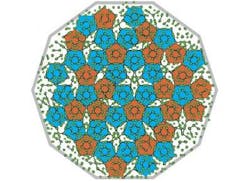Researchers at the University of Michigan (U-M; Ann Arbor, MI) and Argonne National Laboratory (Argonne, IL) have modeled what they call "the most complicated crystal structure ever produced in a computer simulation": an icosahedral quasicrystal whose basic unit can be a nanoparticle or a colloidal particle. Such crystals can be self-assembled from a fluid phase, the simulations show, and could have photonic bandgap properties.1
The icosahedral symmetry of such crystals is forbidden in a conventional crystal, because icosahedra do not nicely fill space in a periodic manner. But icosahedral quasicrystals are nonperiodic and yet retain long-range order.
"An icosahedral quasicrystal is nature’s way of achieving icosahedral symmetry in the bulk. This is only possible by giving up periodicity, which means order by repetition. The result is a highly complicated structure," says Michael Engel, a U-M researcher.
Icosahedral quasicrystals, commonly found in metal alloys, earned the chemist who discovered them more than 30 years ago a Nobel Prize. But engineers are still searching for efficient ways to make them with other materials.
Due to their high symmetry under rotation, they can have a photonic bandgap. "If icosahedral quasicrystals could be made from nano- and micrometer-sized particles, they could be useful in a variety of applications including communication and display technologies, and even camouflage," said Sharon Glotzer, another U-M researcher.
Source: http://ns.umich.edu/new/releases/22593-world-s-most-complex-crystal-simulated-at-u-michigan
REFERENCE:
1. Michael Engel et al., Nature Materials, published online 08 December 2014; doi:10.1038/nmat4152

